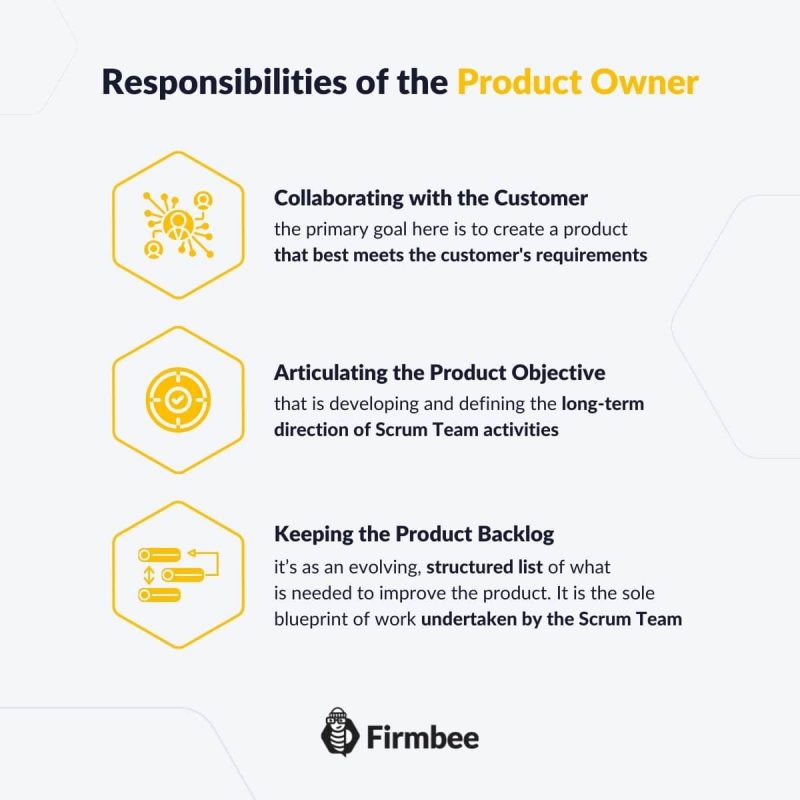It may happen even though consisting of experienced specialists, the Development Team can’t find their work swift and efficiently enough. When looking back at the big picture after the project terminates, it often turns out that it’s the lack of a defined goal was to blame for that situation. When working under the Scrum framework, in order to prevent those and other troubling issues, the creators of the position of the Product Owner, a role which we’re going to focus on in our article today.
Product Owner – table of contents:
- Responsibilities of the Product Owner
- Voice of the Customer in the Scrum Team
- Product Owner and its Purpose
- Backlog Guardian
- Summary
Responsibilities of the Product Owner
Only the Product Owner can make entries in the Product Backlog as well as make a final call in case of doubts concerning customer expectations. The basic responsibilities of this role include:
- Collaborating with the Customer – having regular conversations with the customer that lead to defining and specifying the features of the Product created by the Scrum Team; the primary goal here is to create a product that best meets the customer’s requirements.
- Articulating the Product Objective– that is developing and defining the long-term direction of Scrum Team activities, and making sure that all team members understand it.
- Keeping the Product Backlog – we’ll discuss Product Backlog in a separate dedicated article, but for now, it’s enough to say that it’s one of the Scrum Artifacts, defined in the official Scrum Guide. It’s as an evolving, structured list of what is needed to improve the product. It is the sole blueprint of work undertaken by the Scrum Team. So let’s take a closer look at the role of the Product Owner in the Scrum Team.

Voice of the Customer in the Scrum Team
The Product Owner takes the angle of the customer in the Scrum Team. Thanks to the presence of this role, the Scrum Team can tackle their doubts on an ongoing basis. They don’t have to interpret on their own the often unclear guidelines left by the customer.
Taking decisions regarding the Product, establishing the priorities of the Development Team together with creating and organizing the entries in the Product Backlog the make the Product Owner is such a key member of the team.
The daily regular involvement of the Product Owner with the Development Team and the Scrum Master is crucial because of the short duration of Sprints. These are periods of intense work on the creation of Product Increment – a topic we’ll cover in a separate article.
There is no time to send questions to someone working in a different location and distance wait for an answer. Hence, it’s the Product Owner who becomes a customer representative within the team. The team is present in it.
The Product Owners also attend all Scrum Team meetings to stay up-to-date with the progress of the Development Team. By recognizing the difficulties of co-workers, they can provide reliable information to the Customer and efficiently organize the work of the team.
This occupation is to bridge the gap between the Scrum Team environment, i.e., the business environment, and the Developers. Also, to organize the work of the Developers Team as well as decide what are the criteria for completing the work on a given solution. And also approves of the moment of their fulfillment.
Product Owner and its Purpose
The Product Owner is responsible for clearly defining and clarifying the Product Goal, i.e., defining the purpose of the team’s work. In other words, this includes conceptual and organizational work, the purpose of which is mainly handling User Stories: creating the concept of the product and its functionality that correspond to and meet the Customer’s needs. An equally large share of the Product Owner’s duties concern management work – organizing and prioritizing the tasks in the Product Backlog.
From the Scrum Team perspective, it means taking care of the clarity of the activity horizon. We’ll talk about the Product Goal in a separate entry. Today we’ll use an example:
Let the goal of the Scrum Team be to create a mobile app for organizing the team’s work. The Product Owner’s task is to explain to the Scrum Team members what are the key functionalities of the application from the customer’s point of view. For example – adding new team members by contact list or switching between the team and personal calendar views.
Once the team understands the Product Objective, it will be up to the Product Owner to:
- keeping the right course – so that always the most prominent functionality of the created application is in line with the Product Goal, i.e., organizing the team’s work
- clarifying more detailed issues – searching together with the team, agreeing and specifying how the Product works
- keeping an eye on priorities – following the ‘first things first’ principle, the Product Owner’s task will be, for example, to prevent the development of side or additional application functionalities which are of secondary importance from the customer’s point of view
Aquiring Customer or even Stakeholder vantage point makes Product Owners key decision-makers in the process of Product creation. What’s more, they take part in discussions with people from outside the Scrum Team and carry the burden of valuable Product delivery to Customer.

Backlog Guardian
The daily duties of the Product Owner include organizing the elements of the Product Backlog. This is a daunting task, as it keeps changing throughout the whole endeavor of the project. That written log contains all known measures and steps leading to the realization of the Product Goal. Of course, they are finely segregated and prioritized prior to their execution.
The Product Owner refines the tasks included in the Product Backlog and divides them into smaller. Then he decides which of them are ready to enter the implementation stage.
On one hand, working with the Product Backlog is administrative and organizational work, which requires understanding the nature, capabilities, and limitations of the Developer Team’s work. On the other hand, the Product Owner’s task is to understand the nature, capabilities, and limitations of the work of the Development Team, as well as the external business conditions of Product development.
Yet on the other, the Product Owner’s task is to create the Product Backlog according to the Scrum Team’s needs. It must be clear, accessible, and understandable for all team members. On the other hand, the Product Owner is responsible for answering all the questions and doubts that Scrum Master and Developers have about the product. Thanks to him, the whole team knows what has already been done, what is in progress, and what still needs to be done.
Summary
The Product Owner plays the key role in the Scrum framework. Product Owner constantly guiding the team towards the goal, keeping the Product Backlog complete, safe, and clear, and last but not least, speaking the voice of the Customer in the Scrum Team.
The tasks performed by the Product Owner are so challenging that we devoted the next entry to covering the issue. There, you’ll find the most common mistakes made by the Product Owner and ways of dealing with them.
If you like our content, join our busy bees community on Facebook, Linkedin and Twitter.
Author: Caroline Becker
As a Project Manager, Caroline is an expert in finding new methods to design the best workflows and optimize processes. Her organizational skills and ability to work under time pressure make her the best person to turn complicated projects into reality.
Scrum Guide:
- Glossary of basic terms, roles and notions
- What is Scrum?
- Scrum values
- How to implement Scrum in your company?
- Scrum Team - what is it and how does it work?
- Who is a Product Owner?
- The most common mistakes of Product Owner
- Who is the Scrum Master?
- Characteristics of a good Scrum Master
- The most common mistakes of Scrum Master
- What statistics and metrics should the Scrum Master track?
- Cooperation between Product Owner and Scrum Master
- Development Team in Scrum
- The most common mistakes of Developers
- Scrum artifacts
- Scaling Scrum
- Sprint Backlog
- What is the Product Backlog?
- What are User Stories?
- Creating the best User Story with INVEST
- The most common User Story mistakes
- User Story Acceptance Criteria
- Estimation and Story Points in Scrum
- Planning Poker
- Team Estimation Game
- Defining Increment
- Scrum events
- What is Sprint in Scrum?
- Scrum Team Commitments - Product Goal, Sprint Goal and Definition of Completion
- What is a Burndown Chart?
- How to create and interpret a burndown chart?
- Advantages and disadvantages of the burndown chart
- Kanban boards in Scrum and Scrumban
- Velocity in Scrum - Speed of the Development Team
- Daily Scrum
- Sprint Planning
- Sprint Review
- What is a Sprint Retrospective?
- Common mistakes during a Sprint Retrospective
- Product Backlog nurturing


















